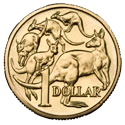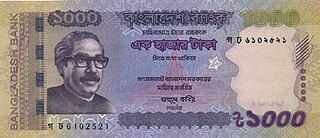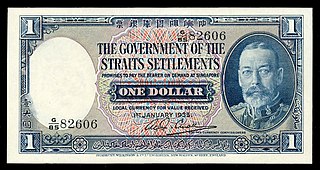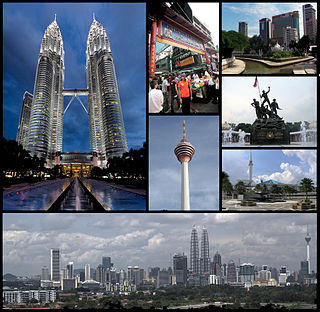
The Australian dollar is the currency of Australia, and of three independent Pacific Island states, specifically Kiribati, Nauru, and Tuvalu. It was introduced on 14 February 1966 when the pre-decimal Australian pound, with subunits of shillings and pence, was replaced by the new decimal currency, the Australian dollar.
Legal tender is a medium of payment recognized by a legal system to be valid for meeting a financial obligation. Paper currency and coins are common forms of legal tender in many countries. Legal tender is variously defined in different jurisdictions. Formally, it is anything which when offered in payment extinguishes the debt. Thus, personal cheques, credit cards, and similar non-cash methods of payment are not usually legal tender. The law does not relieve the debt obligation until payment is tendered. Coins and banknotes are usually defined as legal tender. Some jurisdictions may forbid or restrict payment made other than by legal tender. For example, such a law might outlaw the use of foreign coins and bank notes or require a license to perform financial transactions in a foreign currency.

The Malaysian ringgit is the currency of Malaysia. It is divided into 100 sen (cents). The ringgit is issued by the Bank Negara Malaysia.

The Brunei dollar, has been the currency of the Sultanate of Brunei since 1967. It is normally abbreviated with the dollar sign $, or alternatively B$ to distinguish it from other dollar-denominated currencies. It is divided into 100 sen (Malay) or cents (English). The Brunei dollar is issued by the Autoriti Monetari Brunei Darussalam.

The Singapore dollar is the official currency of Singapore. It is divided into 100 cents. It is normally abbreviated with the dollar sign $, or S$ to distinguish it from other dollar-denominated currencies. The Monetary Authority of Singapore issues the banknotes and coins of the Singapore dollar.

The Bangladeshi taka is the currency of the People's Republic of Bangladesh. Issuance of banknotes ৳10 and larger is controlled by Bangladesh Bank, and for the ৳2 and ৳5 banknotes, which are the responsibility of the Ministry of Finance of the government of Bangladesh. The most commonly used symbol for the taka is "৳" and "Tk", used on receipts while purchasing goods and services. ৳1 is subdivided into 100 poisha.

The Fijian dollar has been the currency of Fiji since 1969 and was also the currency between 1867 and 1873. It is normally abbreviated with the dollar sign $, or alternatively FJ$ to distinguish it from other dollar-denominated currencies. It is divided into 100 cents.
The Jamaican dollar has been the currency of Jamaica since 1969. It is often abbreviated to J$, the J serving to distinguish it from other dollar-denominated currencies. It is divided into 100 cents.

The Netherlands Antillean guilder is the currency of Curaçao and Sint Maarten, which until 2010 formed the Netherlands Antilles along with Bonaire, Saba, and Sint Eustatius. It is subdivided into 100 cents. The guilder was replaced by the United States dollar on 1 January 2011 on Bonaire, Saba and Sint Eustatius. On Curaçao and Sint Maarten, the Netherlands Antillean guilder was proposed to be replaced by a new currency, the Caribbean guilder, but this has been stalled indefinitely by negotiations over the establishment of a separate central bank for Curaçao.

The dollar is the currency of the Cook Islands. The dollar is subdivided into 100 cents, although some 50 cent coins carry the denomination as "50 tene".
The Malayan dollar was the currency of the British colonies and protectorates in Malaya and Brunei until 1953. It was introduced in 1939, replacing the Straits dollar at par, with 1 dollar = two shillings four pence sterling.

The Straits dollar was the currency of the Straits Settlements from 1898 until 1939. At the same time, it was also used in the Federated Malay States, the Unfederated Malay States, Kingdom of Sarawak, Brunei, and British North Borneo.
The daler was the currency of the Danish West Indies between 1849 and 1917, and of the United States Virgin Islands between 1917 and 1934.

The Malaya and British Borneo dollar was the currency of Malaya, Singapore, Sarawak, North Borneo, Brunei and Riau archipelago from 1953 to 1967 and was the successor of the Malayan dollar and Sarawak dollar, replacing them at par. The currency was issued by the Board of Commissioners of Currency, Malaya and British Borneo. Prior to 1952, the board was known as the Board of Commissioners of Currency, Malaya.
The British North Borneo dollar was the currency of British North Borneo from 1882 to 1953. It was subdivided into 100 cents. The dollar had remained at par with the Straits dollar, the currency of Malaya and Singapore, at the value of one dollar to 2 shillings 4 pence sterling from its introduction until both currencies were replaced by the Malaya and British Borneo dollar in 1953. Both coins and banknotes were issued by the British North Borneo Company.

The dollar was the currency of Sarawak from 1858 to 1953. It was subdivided into 100 cents. The dollar remained at par with the Straits dollar and its successor the Malayan dollar, the currency of Malaya and Singapore, from its introduction until both currencies were replaced by the Malaya and British Borneo dollar in 1953.

The Japanese government-issued dollar was a form of currency issued for use within the Imperial Japan-occupied territories of Singapore, Malaya, North Borneo, Sarawak and Brunei between 1942 and 1945. The currency was also referred informally as banana money, named as such because of the motifs of banana trees on 10 dollar banknotes. The Japanese dollar was in widespread use within the occupied territories where the previous currency became a scarcity. The currency were referred to as "dollars" and "cents" like its predecessors, the Straits dollar, Malayan dollar, Sarawak dollar and British North Borneo dollar.
Banknotes were issued by the Chartered Bank of India, Australia and China at its Taiping, Perak branch from 1859 until 1890. These notes, which are very scarce are inscribed 'Post Bill'. Taiping's name is spelt as 'THAIPING'. These notes have the British coat of arms at the top with the inscription 'INCORPORATED BY ROYAL CHARTER' above it. The notes all measure 200 x 120 mm.
The banknotes of the Sungei Buloh Settlement were issued as leprosy colony money in 1935 and 1936, at Sungei Buloh, when it was a leper colony. The currency was based on the Straits Settlements dollar. These notes are extremely scarce. They were all printed by the Survey Department, Federated Malay States. They have never been listed in the Standard Catalog of World Paper Money.
Leper colony money was special money which circulated only in leper colonies due to the fear that money could carry leprosy and infect other people. However, leprosy is not easily transmitted by casual contact or objects; actual transmission only happens through long-term, constant, intimate contact with leprosy sufferers and not through contact with everyday objects used by sufferers.

Kuala Lumpur, officially the Federal Territory of Kuala Lumpur, or commonly known as KL, is the national capital and largest city in Malaysia. As the global city of Malaysia, it covers an area of 243 km2 (94 sq mi) and has an estimated population of 1.73 million as of 2016. Greater Kuala Lumpur, also known as the Klang Valley, is an urban agglomeration of 7.25 million people as of 2017. It is among the fastest growing metropolitan regions in Southeast Asia, in both population and economic development.

Malaysia is a country in Southeast Asia. The federal constitutional monarchy consists of 13 states and three federal territories, separated by the South China Sea into two similarly sized regions, Peninsular Malaysia and East Malaysia. Peninsular Malaysia shares a land and maritime border with Thailand in the north and maritime borders with Singapore in the south, Vietnam in the northeast, and Indonesia in the west. East Malaysia shares land and maritime borders with Brunei and Indonesia and a maritime border with the Philippines and Vietnam. Kuala Lumpur is the national capital and largest city while Putrajaya is the seat of federal government. With a population of over 30 million, Malaysia is the world's 44th most populous country. The southernmost point of continental Eurasia, Tanjung Piai, is in Malaysia. In the tropics, Malaysia is one of 17 megadiverse countries, with large numbers of endemic species.















